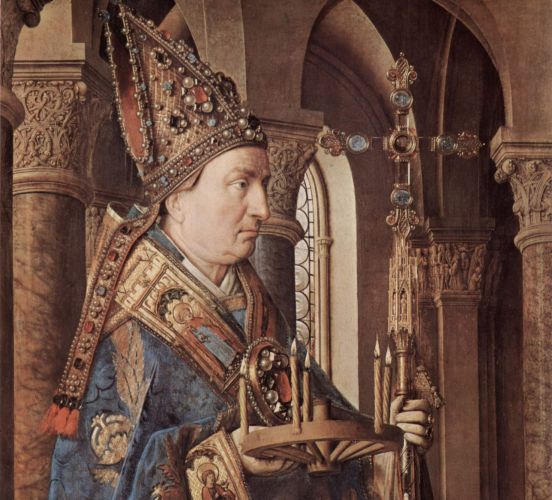
Posted on 06/01/2008 5:57:49 PM PDT by Salvation

|
|
|
When vesting for the liturgy, the cleric |
||
|
|
||
|
Then he puts on his: |
||
|
The amice is a rectangular piece of white linen with two strings at the upper corners which a cleric uses underneath his alb to cover the neck so that the Roman collar of the cassock is hidden. The word amice comes from the Latin amicire, meaning "to cover" and, because the heads of criminals condemned to death were covered in linen, the amice recalls the humiliation which was put upon Christ. As he puts on the amice, the priest kisses the Cross on the Amice and prays: Place upon me, O Lord, the helmet of salvation, that I may overcome the assaults of the devil. |
||
|
|
Alb
Purify me, O Lord, and cleanse my heart; that, being made white in the Blood of the Lamb, I may come to eternal joy. |
|
|
|
Cincture The cincture ties the alb at the waist. As he ties it, he prays: Gird me, O Lord, with the girdle of purity, and extinguish in me all evil desires, that the virtue of chastity may abide in me. |
|
|
|
Maniple
Grant, O Lord, that I may so bear the maniple of weeping and sorrow, that I may receive the reward for my labors with rejoicing.
|
|
|
|
Stole
Restore unto me, O Lord, the stole of immortality, which was lost through the guilt of our first parents: and, although I am unworthy to approach Your sacred Mysteries, nevertheless grant unto me eternal joy. |
|
|
|
Chasuble or Cope For the Eucharistic Liturgy: Chasuble O Lord, Who said: My yoke is easy and My burden light: grant that I may bear it well and follow after You with thanksgiving. Amen. For non-Eucharistic Liturgy: Cope Lord, endow me with the garment of salvation, the vestment of joy, and with the dalmatic of justice ever encompass me. Biretta The biretta is a tri-cornered or square-shaped hat with silk trim, tuft (except for the birette of seminarians and cardinals) and three raised wings, called "horns," on top at three corners (the side of the hat without the horn is worn on the left side of the head). It is made of scarlet silk for cardinals, violet silk for bishops, and black merlino for priests, deacons, and seminarians. |
|
|
In addition to the above, |
||
| Pectoral Cross The pectoral cross is a cross, usually about 6 inches in height, worn around the neck of a bishop and suspended by either cord (in liturgical vestments or choir) or chain (in abito piano). The cord is scarlet and gold for a cardinal; green and gold for a bishop. The pectoral cross is worn on the chest of prelates so as to keep the Cross close to their hearts. Crozier The crozier is the shepherd's staff used by bishops. The crozier has always been in the Church a symbol of the bishop's pastoral role. In the very early Church, it was made of wood, but in the early Middle Ages metal (silver and gold, depending on rank) was used instead. Wooden croziers again began to be used during the time of Vatican II and are common today. Episcopal Ring When a Bishop is consecrated as Bishop, he receives a ring representing his office (Cardinals receive their own special ring, also). The Pope's ring, known as the "Fisherman's Ring," is the personal and unique seal of that reigning Pontiff and is (or at least used to be) destroyed on his death. Zucchetto The zucchetto is the silk yarmulka-like skullcap worn by bishops. The Pope's zucchetto is white; the cardinals' zucchetti are scarlet; the bishops' zucchetti are violet. Priests may use a black cloth zucchetto for everyday wear, but not during the liturgy. Mitre The mitre imitates the Old Testament priestly headcovering and is the headdress of bishops, worn at liturgical functions. It is either precious, golden (orphreyed), or simple (simplex). The precious mitre is worn by celebrants, the simple by concelebrants, and the golden by the celebrant at an ordination. All cardinals wear a damasked mitre (simplex) in presence of the Pope. It is very tall and made of layered white damask silk. |
||
|
In addition to the above, |
||
| Pallium The pallium is worn only by archbishops (in their own dioceses), patriarchs, and the Pope, as symbol of their authority. It's a band of white wool adorned with 6 small black crosses, worn around the neck with extensions front and back, and pinned to the chasuble in three places about the neck. The non-silk part of the pallium is made of white wool, part of which is supplied by two lambs presented annually by the Lateran Canons Regular on the feast of St. Agnes (21 January). The lambs are solemnly blessed on the high altar of that church after the pontifical Mass, and then offered to the pope, who sends palliums made of their wool to the archbishops. |
||
|
In addition to the above, the Pope wears a: |
||
|
|
Fanon The fanon is a vestment , rarely used nowadays, reserved for the Pope during a pontifical Mass. It consists of a double mozzetta (short shoulder-cape worn by bishops outside the liturgy), the first going under the stole and the second over the chasuble.
|
There will be a complete series on this subject, The Sacrifice of the Mass. I skipped many -- so will do the rest when finished with the Apostles' Creed series.
Oops......I keep forgetting the [Ecumenical]
Could you please add it for me at your pleasure?
Thanks in advance.
Please notify me via FReepmail if you would like to be added to or taken off the Catholic Discussion Ping List.
I thought this would be very interesting to go along with the thread that NYer posted about bishops.
Now all the children can impress their religious ed teachers by knowing the names of the priest’s vestments! LOL!
I think the history of vestments is fascinating. I hope some of our Greek brethren chip in.
Me too. There is so much rich history here. This article just brushes the surface.
The Vesting Prayers from the Liturgy of St. John Chrysostom:
The Alb
My soul shall rejoice in the Lord, for He has clothed me with the garment of salvation; He has covered me with the robe of gladness; as a bridegroom He has set a crown on me; and as a bride adorns herself with jewels,so He has adorned me.
The Cincture
Blessed is God, who girds me with strength and makes my way blameless. He made my feet like hinds’ feet, and sets me secure on the heights.
The Stole
Blessed is God, who pours out his grace upon his ministers, as myrrh upon the head, that runs down the beard, the beard of Aaron, that runs down the border of his robe.
The Maniple
Thy hands have made and fashioned me. Give me understanding, that I may learn thy commandments.
The Chasuble
Thy priests, O Lord, will clothe themselves with righteousness, and Thy people will rejoice with joy always, now and ever and unto ages of ages, Amen
Thanks.
The historic Eucharistic vestments are also used by the more conservative and traditionalist Episcopalians and Lutherans.
I know of a young Episcopal Priest who uses nothing but “Fiddleback” Chasubles with Amice and Maniple in his parish in rural Maryland—and a good many Lutherans of similar sensibilites (except for the fiddlebacks) among the subscribers to the Rule of the Society of the Holy Trinity http://www.societyholytrinity.org.
 a nickel for every time i helped the Priest get ready for mass when i was an AlterBoy... and since i lived a block away, i ALWAYS got called when ever somebody couldn't make it. lucky me.
a nickel for every time i helped the Priest get ready for mass when i was an AlterBoy... and since i lived a block away, i ALWAYS got called when ever somebody couldn't make it. lucky me.
thanks ~ very cool! brings back some memories.
Thanks. Keeping it on was the first thing that I thought of.
Disclaimer: Opinions posted on Free Republic are those of the individual posters and do not necessarily represent the opinion of Free Republic or its management. All materials posted herein are protected by copyright law and the exemption for fair use of copyrighted works.